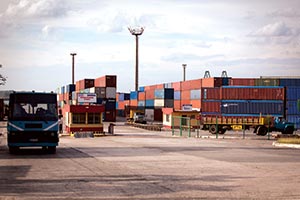US Firms Eye Cuba Trade, Focus on Port of Mariel

This story appears in the April 4 print edition of Transport Topics.
The Cuban government is offering incentives to attract foreign investment in the Port of Mariel, with the goal of establishing the port as a major shipping point for goods moving throughout the Caribbean and to and from the United States.
The port was the site of the Mariel boat lift in 1980, when tens of thousands of Cubans left for the United States. A delegation of U.S. logistics executives who toured it recently said they found it to be “state of the art” and equipped to handle a significant increase in container shipments once the U.S. embargo is lifted.
“We were extremely impressed,” Will Sehestedt, government affairs manager for the Transportation Intermediaries Association, said in an interview with Transport Topics after returning from a TIA-sponsored trade mission that happened to coincide with a historic trip to Cuba by President Obama.
Obama’s visit to Cuba last month opened a new era in the United States’ thorny relationship with Cuba, the tiny nation 90 miles south of Florida.
In contrast to conditions at the port, TIA officials said, roadways, railways and airport facilities in Cuba are all in need of significant investment and could take years to modernize. Most goods moving within Cuba, in fact, are carried aboard ships rather than on trucks because many roads outside major cities are unpaved.
While the group found Cubans to be enthusiastic about the potential for trade with the United States, Sehestedt said changes will likely be “gradual” because the Cuban government controls large segments of the economy, and Cuban leaders want to protect what they see as the island nation’s “cultural identity.”
“I’m not too optimistic,” said Thomas Van Mouwerik, president of Bill Hay International Inc., a customs brokerage and logistics firm based in San Diego. “Laws need to change.” For example, he said, foreign companies are not allowed to pay employees directly and nearly all goods coming into the country must go through state-controlled organizations.
At the airport in Havana, Van Mouwerik said, you see travelers carrying massive bundles with goods purchased outside the country. “It’s a weird, inefficient way to get goods into the country,” he noted.
Jodi Bond, vice president of the Americas at the U.S. Chamber of Commerce, also noted the need for changes in the United States and Cuba.
“The embargo must be definitely addressed,” Bond told TT. “Yet even if the embargo were lifted tomorrow, many impediments in the Cuban system remain in place that prevent U.S. sales to, and investment in, the island.”
Sehestedt said the businesses targeted by the Cuban government for development include: hospitality, biotech and medical, light manufacturing, oil and gas and production of cigars, rum and coffee.
Rob Kemp, president of DRT Transportation, a Pennsylvania-based freight management firm, said Cuba represents an untapped market of nearly 12 million people and he sees a lot of opportunity for U.S. companies to sell products there. “It makes sense, and I think it’s going to happen,” he said, “But it will take a lot of time. The resources are just not there yet.”
Van Mouwerik and Kemp were part of the TIA delegation that included representatives from C.H. Robinson Worldwide, JZ Expedited Logistics, Mercantile Logistics & International Trade, Carrier Services of Tennessee and DRI Worldwide, a representative of Nasstrac, a trade association representing less-than-truckload and parcel shippers, and three TIA staff members.
C.H. Robinson ranks No. 4 on the new Transport Topics Top 50 list of the largest logistics companies in North America.
Adam Bridges, senior vice president of corporate strategy at Florida East Coast Railway in Jacksonville, Florida, said his company is “excited” about the prospect of trade with Cuba and has already started to help customers with shipments of poultry and other food products, along with materials that can be used for private residential construction and remodeling.
While the U.S. government has loosened some restrictions on exports to Cuba, allowing trade with individuals and private businesses, for example, it continues to prohibit transactions with government agencies.
“We anticipate a steady increase [in trade] as the Cuban people are able to accumulate U.S. dollars and gain access to credit,” Bridges said.
Florida East Coast Railway serves three ports in South Florida — the Port of Palm Beach, Port Everglades in Fort Lauderdale and the Port of Miami — that are most likely to benefit from trade with Cuba, Bridges said.
While the Port of Mariel will be able to handle new supersize containerships after the opening of the widened Panama Canal this year, Bridges said he would expect the bigger ships to dock in South Florida first and then “dump and run” goods to Cuba and other locations in the Caribbean using smaller feeder ships.
Several shipping lines in South Florida have received licenses to provide passenger and freight service to Cuba, although they may still require approval from the government of Cuba, he said.

